Perceiving Fifth Facade Colors in China’s Coastal Cities from a Remote Sensing Perspective: A New Understanding of Urban Image
Abstract
1. Introduction
2. Materials and Methods
2.1. Study Area
- Wide spatial distribution. China’s coastal cities are distributed in a belt-like pattern (Figure 1), spanning from 18.36°N (Sanya) to 41.45°N (Jinzhou) and from 108.01°E (Fangchenggang) to 124.40°E (Dandong). They comprehensively cover tropical, subtropical, and temperate zones, making them ideal for analyzing spatial variations in FFC.
- Complex natural and built environments. Coastal areas feature diverse ecosystems, including wetlands, estuaries, and mangroves. Proximity to the sea means factors like salt spray, humidity, and sea breezes significantly influence land surface colors and composition, giving these areas unique natural characteristics. Additionally, over 70% of China’s medium-to-large cities are located in coastal regions, which are more urbanized than other areas [23]. This combination of natural and urban landscapes makes coastal cities ideal for studying FFC complexity.
- Thriving tourism industry. Coastal cities often rely heavily on tourism and leisure industries. Understanding their FFC can help analyze how colors influence tourist behavior and support decision-making in land use and landscape development.
2.2. China’s Urban Built-Up Dataset
2.3. Natural Color Optimization Algorithm for Sentinel-2 Images
2.4. Characteristic Indicators of FFC
2.4.1. Dominant Colors
2.4.2. HSV Color Space
2.4.3. Color Richness
2.4.4. Color Harmony
3. Results
3.1. True-Color Composite Remote Sensing Images vs. Optimized Natural-Color Products
3.2. Typical Characteristics of Fifth Facade Colors (FFCs) in China’s Coastal Cities
3.2.1. Dominant Colors
3.2.2. Hue, Saturation, and Value
3.2.3. Color Richness and Color Harmony
- (1)
- First quadrant (top right): Cities like Weifang, Lianyungang, and Tianjin excel in both richness and harmony, indicating well-planned and diverse fifth facades with aesthetic harmony. Geographically, most cities in this quadrant are located in northern coastal regions, except for Haikou, Shanghai, and Nantong.
- (2)
- Second quadrant (top left): Cities like Macao, Jiaxing, and Ningbo have low richness but high harmony, indicating a clear dominant color tone that creates a simple and coordinated visual aesthetic. These cities are mostly located in southern and southeastern coastal regions.
- (3)
- Third quadrant (bottom left): Cities like Shanwei, Zhuhai, and Taizhou have low richness and harmony, suggesting a lack of consideration for the color coordination between dominant FFC tones and scattered landscapes. These cities are also located in southern and eastern coastal regions.
- (4)
- Fourth quadrant (bottom right): Cities like Qingdao, Tangshan, and Yantai have high richness but low harmony, indicating potential severe color pollution in their fifth facades.
4. Discussion
4.1. Perceiving Urban Image from the FFC Perspective
4.2. Advantages of Natural Color Optimization in Remote Sensing Data
4.3. Implications for Coastal City Planning and Industry Development
4.4. Future Work and Limitations
5. Conclusions
Supplementary Materials
Author Contributions
Funding
Data Availability Statement
Conflicts of Interest
Abbreviations
| FFC | The Fifth Facade Color |
| RGB | Red, Green, and Blue |
| CIE | International Commission on Illumination |
| CMF | Color-Matching Functions |
| ASTER | Advanced Spaceborne Thermal Emission and Reflection Radiometer |
| RMSE | Root Mean Square Error |
| HSV | Hue, Saturation, and Value |
| MODIS | Moderate-resolution Imaging Spectroradiometer |
| GEE | Google Earth Engine |
| PVC | Polyvinyl Chloride |
| NASA | National Aeronautics and Space Administration |
References
- Wang, H.; Wang, H.; Hu, X. Artistic Expression of Urban Community Landscape Color. In Proceedings of the 2014 2nd International Conference on Education Technology and Information System (ICETIS 2014), Jinan, China, 26 April 2014. [Google Scholar]
- Zhang, C.; Chen, Y.; Dewancker, B.J.; Shentu, C.; Tian, H.; Liu, Y.; Wan, J.; Zhang, X.; Li, J. Emotional Landscapes in Urban Design: Analyzing Color Emotional Responses of the Elderly to Community Outdoor Spaces in Yi Jie Qu. Buildings 2024, 14, 793. [Google Scholar] [CrossRef]
- Xu, Z.; Zheng, X. Roadmap of moving urban colour toward cultural sustainability in China. Color Res. Appl. 2021, 46, 222–239. [Google Scholar] [CrossRef]
- Lynch, K. Reconsidering the Image of the City; Springer: Boston, MA, USA, 1984; pp. 151–161. [Google Scholar]
- Badami, A.A. Management of the image of the city in urban planning: Experimental methodologies in the colour plan of the Egadi Islands. Urban Des. Int. 2022, 30, 1–16. [Google Scholar] [CrossRef]
- Nguyen, L.; Teller, J. Color in the urban environment: A user-oriented protocol for chromatic characterization and the development of a parametric typology. Color Res. Appl. 2017, 42, 131–142. [Google Scholar] [CrossRef]
- Gou, A.; Shi, B.; Wang, J.; Wang, H. Color preference and contributing factors of urban architecture based on the selection of color samples—Case study: Shanghai. Color Res. Appl. 2022, 47, 454–474. [Google Scholar] [CrossRef]
- Jaglarz, A. Perception of color in architecture and urban space. Buildings 2023, 13, 2000. [Google Scholar] [CrossRef]
- Zhong, T.; Ye, C.; Wang, Z.; Tang, G.; Zhang, W.; Ye, Y. City-scale mapping of urban façade color using street-view imagery. Remote Sens. 2021, 13, 1591. [Google Scholar] [CrossRef]
- Cook, R.; Gilbert, J. The fifth façade: Designing nature into the city. Council. Tall. Build. Urban. Habitat. 2015, 1, 288. [Google Scholar]
- Köhler, M.; Clements, A.M. Green Roofs: Ecological Functions of the Fifth Facade. In Sustainable Built Environments. Encyclopedia of Sustainability Science and Technology Series; Loftness, V., Ed.; Springer: New York, NY, USA, 2020; pp. 495–518. [Google Scholar] [CrossRef]
- Liu, G.; Hong, S.; Wang, Y.; Dai, L.; Wei, W. Study of the fifth façade: Planning and controlling in the wuhan aerotropolis. In Human-Centered Urban Planning and Design in China: Volume II: Urban Design and Mobility; Springer: Cham, Switzerland, 2021; pp. 29–39. [Google Scholar] [CrossRef]
- Chen, T. Research on Industrial Building Facade Design in Urban Core Area. In Proceedings of the 2024 7th International Conference on Structural Engineering and Industrial Architecture (ICSEIA 2024), Guangzhou, China, 29 March 2024. [Google Scholar] [CrossRef]
- Robles Romera, A. Collective Space in Height: The Fifth Façade. Bachelor’s Thesis, Universitat Politècnica de Catalunya, Barcelona, Spain, 2021. [Google Scholar]
- Belgiu, M.; Stein, A. Spatiotemporal image fusion in remote sensing. Remote Sens. 2019, 11, 818. [Google Scholar] [CrossRef]
- Gao, C.; Cheng, D.; Liu, K. Research on small-area fish landscape from the perspective of the fifth facade: Taking the Chang’an Campus of Northwest University as an example. J. Cent. China. Norm. Univ. 2016, 50, 770. (In Chinese) [Google Scholar]
- Rizzo, R.; Wadoux, A.M.C.; Demattê, J.A.; Minasny, B.; Barrón, V.; Ben-Dor, E.; Francos, N.; Savin, I.; Poppiel, R.; Silvero, N.; et al. Remote sensing of the Earth’s soil color in space and time. Remote Sens. Environ. 2023, 299, 113845. [Google Scholar] [CrossRef]
- Ju, J.; Masek, J.G. The vegetation greenness trend in Canada and US Alaska from 1984–2012 Landsat data. Remote Sens. Environ. 2016, 176, 1–16. [Google Scholar] [CrossRef]
- Zhong, Q.; Li, Z. Long-term trends of vegetation greenness under different urban development intensities in 889 global cities. Sustain. Cities Soc. 2024, 106, 105406. [Google Scholar] [CrossRef]
- Xie, Y.; Han, X.; Zhu, S. Synthesis of true color images from the Fengyun advanced geostationary radiation imager. J. Meteorol. Res. 2021, 35, 1136–1147. [Google Scholar] [CrossRef]
- Sovdat, B.; Kadunc, M.; Batič, M.; Milčinski, G. Natural color representation of Sentinel-2 data. Remote Sens. Environ. 2019, 225, 392–402. [Google Scholar] [CrossRef]
- Wernand, M.; Woerd, H.J. WACODI: A generic algorithm to derive the intrinsic color of natural waters from digital images. Limnol. Oceanogr. Methods 2015, 13, 697–711. [Google Scholar] [CrossRef]
- Jia, M.; Zeng, H.; Chen, Z.; Wang, Z.; Ren, C.; Mao, D.; Zhao, C.; Zhang, R.; Wang, Y. Nighttime light in China’s coastal zone: The type classification approach using SDGSAT-1 Glimmer Imager. Remote Sens. Environ. 2024, 305, 114104. [Google Scholar] [CrossRef]
- Sun, J.; Sun, Z.; Guo, H.; Jiang, H.; Gao, J.; Wang, J. Dataset of Chinese Cities Built-Up Area in 2020 (DS/OL); Science Data Bank: Beijing, China, 2021; Volume 1. [Google Scholar] [CrossRef]
- Webster, M.A. Human colour perception and its adaptation. Netw.-Comp. Neural Sys. 1996, 7, 587–634. [Google Scholar] [CrossRef]
- Gordon, H.R. Remote sensing of ocean color: A methodology for dealing with broad spectral bands and significant out-of-band response. Appl. Opt. 1995, 34, 8363–8374. [Google Scholar] [CrossRef]
- Drusch, M.; Del Bello, U.; Carlier, S.; Colin, O.; Fernandez, V.; Gascon, F.; Hoersch, B.; Isola, C.; Laberinti, P.; Martimort, P.; et al. Sentinel-2: ESA’s optical high-resolution mission for GMES operational services. Remote Sens. Environ. 2012, 120, 25–36. [Google Scholar] [CrossRef]
- Smith, T.; Guild, J. The CIE colorimetric standards and their use. Trans. Optic. Soc. 1931, 33, 73. [Google Scholar] [CrossRef]
- Wyman, C.; Sloan, P.P.; Shirley, P. Simple analytic approximations to the CIE XYZ color matching functions. J. Comput. Graph. Tech. 2013, 2, 11. [Google Scholar]
- Baldridge, A.M.; Hook, S.J.; Grove, C.I.; Rivera, G. The ASTER spectral library version 2.0. Remote Sens. Environ. 2009, 113, 711–715. [Google Scholar] [CrossRef]
- Green, P. Colour Encodings. In Fundamentals and Applications of Colour Engineering; John Wiley & Sons: Hoboken, NJ, USA, 2023; pp. 143–154. [Google Scholar] [CrossRef]
- IEC/PWI 61966-2-1/Amd 1:2003; Multimedia Systems and Equipment-Color Measurement and Management-Part 2–1: Color Management-Default RGB Color Space-sRGB. International Electrotechnical Commission: Geneva, Switzerland, 2003.
- MacQueen, J. Some methods for classification and analysis of multivariate observations. In Proceedings of the Fifth Berkeley Symposium on Mathematical Statistics and Probability, Volume 1: Statistics; University of California Press: Berkeley, CA, USA, 1967; Volume 5, pp. 281–298. [Google Scholar]
- Hicks, S.C.; Liu, R.; Ni, Y.; Purdom, E.; Risso, D. Mbkmeans: Fast clustering for single cell data using mini-batch k-means. PLoS Comput. Biol. 2021, 17, e1008625. [Google Scholar] [CrossRef]
- Kuehni, R.G. Color: An Introduction to Practice and Principles; John Wiley & Sons: New York, NY, USA, 2015. [Google Scholar]
- Smith, A.R. Color gamut transform pairs. ACM. Siggraph Comput. Graphics 1978, 12, 12–19. [Google Scholar] [CrossRef]
- Ou, L.C.; Luo, M.R. A colour harmony model for two-colour combinations. Color Res. Appl. 2006, 31, 191–204. [Google Scholar] [CrossRef]
- Pridmore, R.W. Complementary colors theory of color vision: Physiology, color mixture, color constancy and color perception. Color Res. Appl. 2011, 36, 394–412. [Google Scholar] [CrossRef]
- Nemcsics, A. Experimental determination of the laws of color harmony. Part 4: Color preference and the color harmony content. Color Res. Appl. 2009, 34, 210–224. [Google Scholar] [CrossRef]
- Lenclos, J.P. The geography of colour. In Colour for Architecture Today; Taylor & Francis: Oxfordshire, UK, 2019; pp. 39–44. [Google Scholar]
- Xing, Z.; Guo, W. Addressing cities’ color issues and planning urban colors with regional features to preserve the history and culture of cities: The case of Suzhou, Wuxi, and Changzhou (China). J. Asian Archit. Build. Eng. 2024, 1–13. [Google Scholar] [CrossRef]
- Karasov, O.; Külvik, M.; Burdun, I. Deconstructing landscape pattern: Applications of remote sensing to physiognomic landscape mapping. GeoJournal 2021, 86, 529–555. [Google Scholar] [CrossRef]
- Di, Q.; Ji, L. Analysis and Evaluation of Coastal Cities Marine Characteristics from the Perspective of Regional Identity. Sci. Geogr. Sin. 2016, 36, 1688–1696. [Google Scholar] [CrossRef]
- Yu, Z. Regulation of Urban Character: Style, Colour and Historic Character in a Modern Chinese City—The Case of Harbin; The University of Manchester: Manchester, UK, 2013. [Google Scholar]
- Özcan, E.K.; Çelik, K. Environmental color analysis and facade color design in a street rehabilitation: Adana, Kayalıbağ. Color Res. Appl. 2024, 49, 433–448. [Google Scholar] [CrossRef]
- Beyes, T. Organizing Color: Toward a Chromatics of the Social; Stanford University Press: Redwood City, CA, USA, 2024. [Google Scholar]
- O’Donnell, P. Historic urban landscape: A new UNESCO tool for a sustainable future. In Conserving Cultural Landscapes; Routledge: New York, NY, USA, 2014; pp. 163–181. [Google Scholar]
- Yi, J.; Jeon, J. A study on color conspicuity and color harmony of wayfinding signs according to outdoor environment types. Color Res. Appl. 2022, 47, 1259–1294. [Google Scholar] [CrossRef]
- Gou, A.; Wang, J. A comparison between wishes and status: Gray is not the preference for residents while the city shows neutral colors. Color Res. Appl. 2017, 42, 650–663. [Google Scholar] [CrossRef]
- Gretchen, M. Pastel Portraits: Singapore’s Architecture Heritage; Singapore Coordinating Committee: Singapore, 1984. [Google Scholar]
- Schott, J.R. Remote Sensing: The Image Chain Approach; Oxford University Press: Oxford, OH, USA, 2007. [Google Scholar]
- Stöckli, R.; Vermote, E.; Saleous, N.; Simmon, R.; Herring, D. The Blue Marble Next Generation—A True Color Earth Dataset Including Seasonal Dynamics from MODIS; NASA Earth Observatory: Greenbelt, MD, USA, 2005. [Google Scholar]
- Yamaguchi, M.; Haneishi, H.; Ohyama, N. Beyond red–green–blue (RGB): Spectrum-based color imaging technology. J. Imaging Sci. Technol. 2008, 52, 10201. Available online: https://jglobal.jst.go.jp/en/detail?JGLOBAL_ID=200902209340203559 (accessed on 1 January 2025). [CrossRef]
- Crameri, F.; Shephard, G.E.; Heron, P.J. The misuse of colour in science communication. Nat. Commun. 2020, 11, 5444. [Google Scholar] [CrossRef] [PubMed]
- Garcia, J.E.; Girard, M.B.; Kasumovic, M.; Petersen, P.; Wilksch, P.A.; Dyer, A.G. Differentiating biological colours with few and many sensors: Spectral reconstruction with RGB and hyperspectral cameras. PLoS ONE 2015, 10, e0125817. [Google Scholar] [CrossRef]
- Tsagaris, V.; Anastassopoulos, V. Multispectral imag fusion for improved RGB representation based on perceptual attributes. Int. J. Remote Sens. 2005, 26, 3241–3254. [Google Scholar] [CrossRef]
- Sunoj, S.; Igathinathane, C.; Saliendra, N.; Hendrickson, J.; Archer, D. Color calibration of digital images for agriculture and other applications. ISPRS. J. Photogram. Remote Sens. 2018, 146, 221–234. [Google Scholar] [CrossRef]
- Wang, H.; Yang, J.; Xue, B.; Yan, X.; Tao, J. A novel color calibration method of multi-spectral camera based on normalized RGB color model. Results Phys. 2020, 19, 103498. [Google Scholar] [CrossRef]
- Rangel-Buitrago, N. Coastal Scenery: Evaluation and Management, 1st ed.; Springer: Berlin, Germany, 2018; Volume 26. [Google Scholar]
- Wang, J.; Liu, M.; Li, W. Color matching simulation of ocean landscape decoration pattern based on visual communication. J. Coast. Res. 2020, 108, 173–177. [Google Scholar] [CrossRef]
- Zhang, L.; Kim, C. Chromatics in urban landscapes: Integrating interactive genetic algorithms for sustainable color design in marine cities. Appl. Sci. 2023, 13, 10306. [Google Scholar] [CrossRef]
- Martosenjoyo, T. Color in architecture: Before and after industry revolution. J. Soc. Political Sci. 2021, 4, 9. Available online: https://ssrn.com/abstract=3964301 (accessed on 1 January 2025). [CrossRef]
- Chu, D. Aesthetic visual ecology and urban landscape planning. Adv. Mater. Res. 2011, 255, 1479–1483. [Google Scholar] [CrossRef]
- Divers, E. Theory to practice: Pleasure-Arousal-Dominance (PAD) theory for architectural color design. Color Res. Appl. 2023, 48, 445–452. [Google Scholar] [CrossRef]
- Qi, Z.; Li, J.; Yang, X.; He, Z. How the characteristics of street color affect visitor emotional experience. Comput. Urban Sci. 2025, 5, 7. [Google Scholar] [CrossRef]
- Hunjet, A.; Glogar, M.I.; Osterman, D.P.; Kozina, G. The importance of color as a marketing tool in tourism. In Proceedings of the 13th International Scientific Conference on Economic and Social Development, Barcelona, Spain, 14–16 April 2016. [Google Scholar]
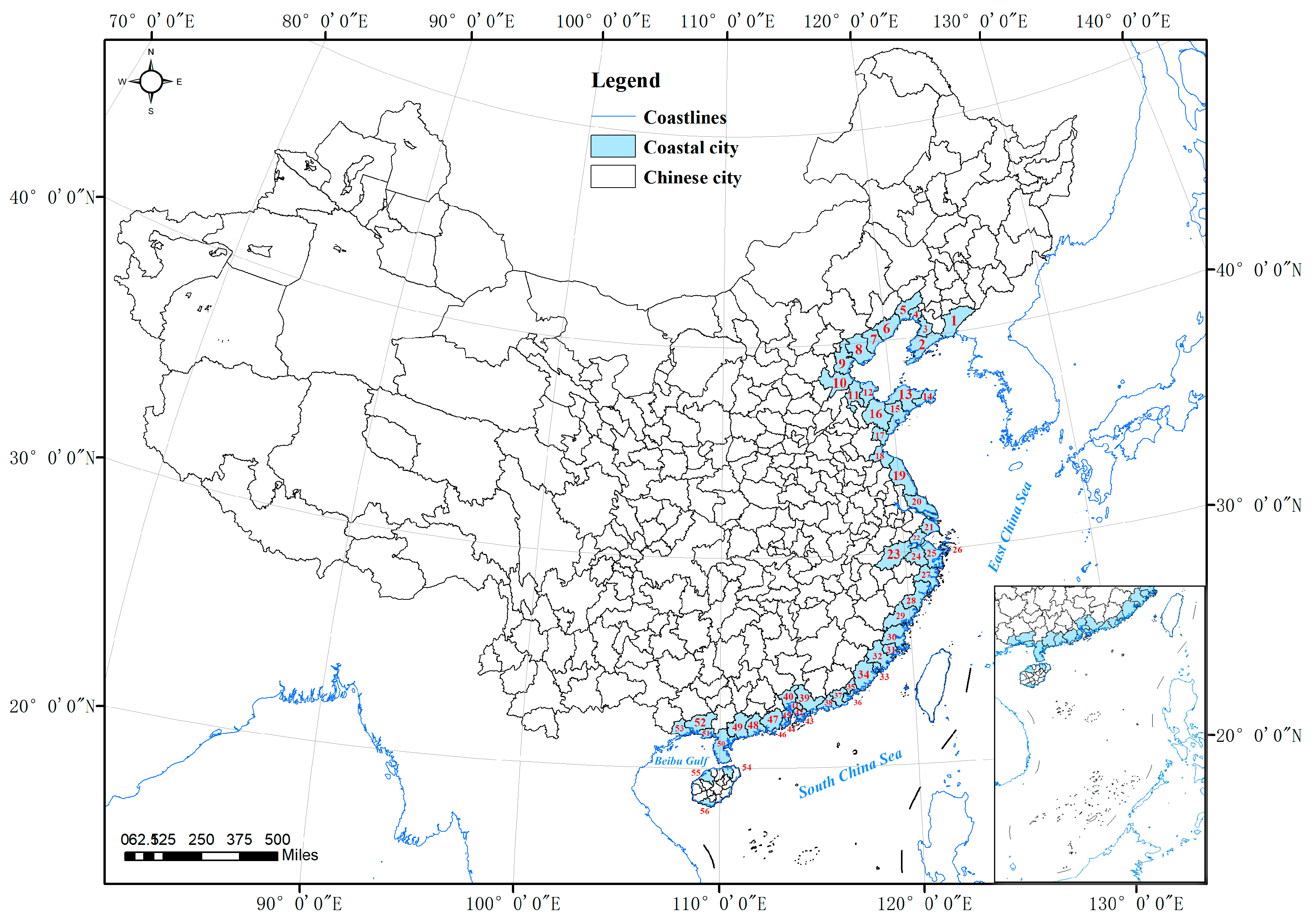



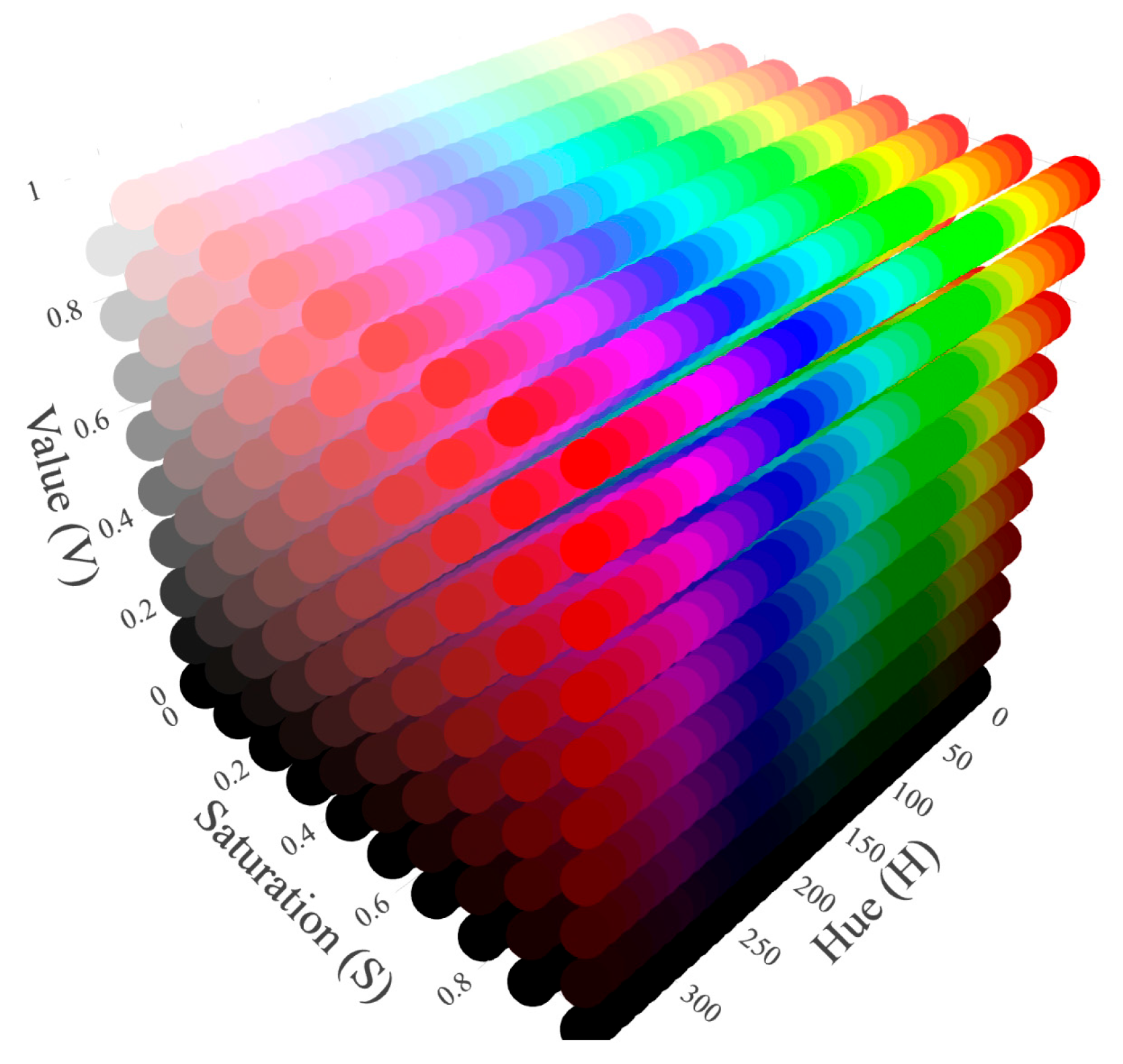
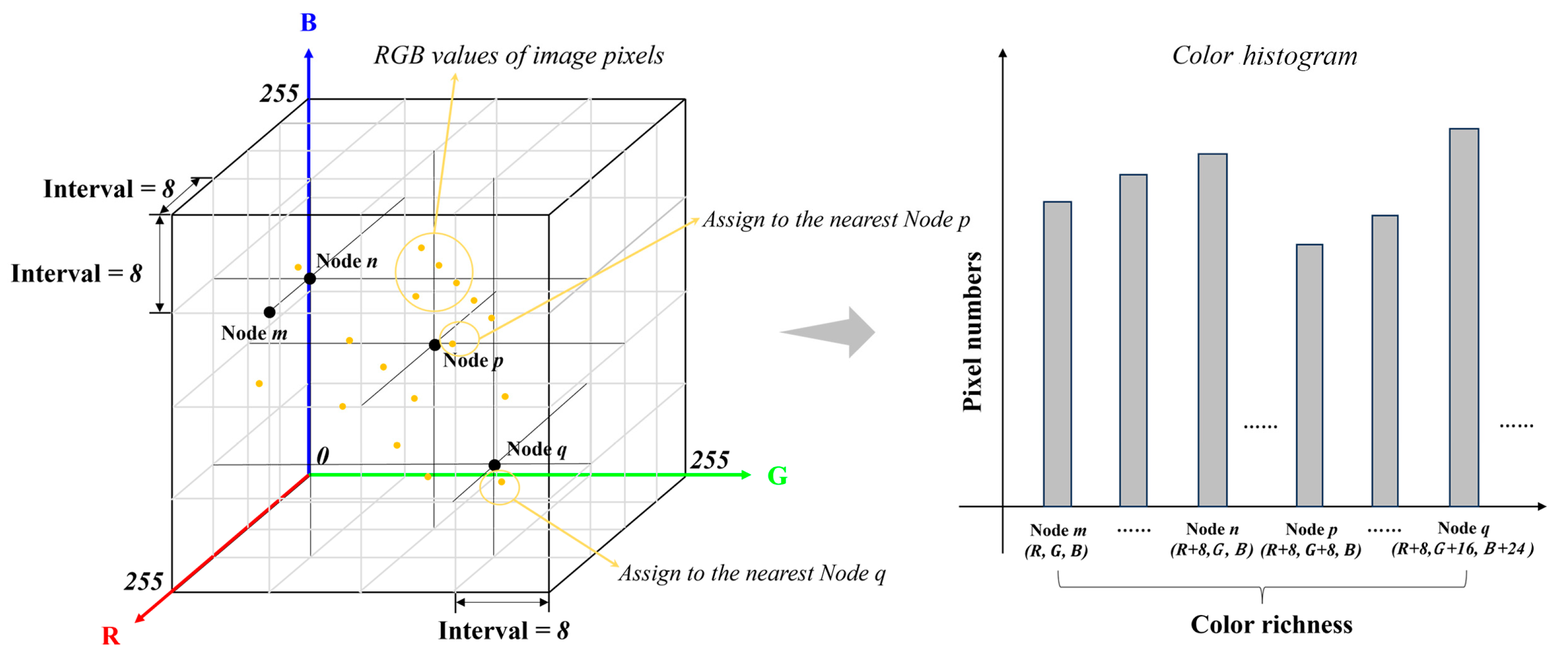

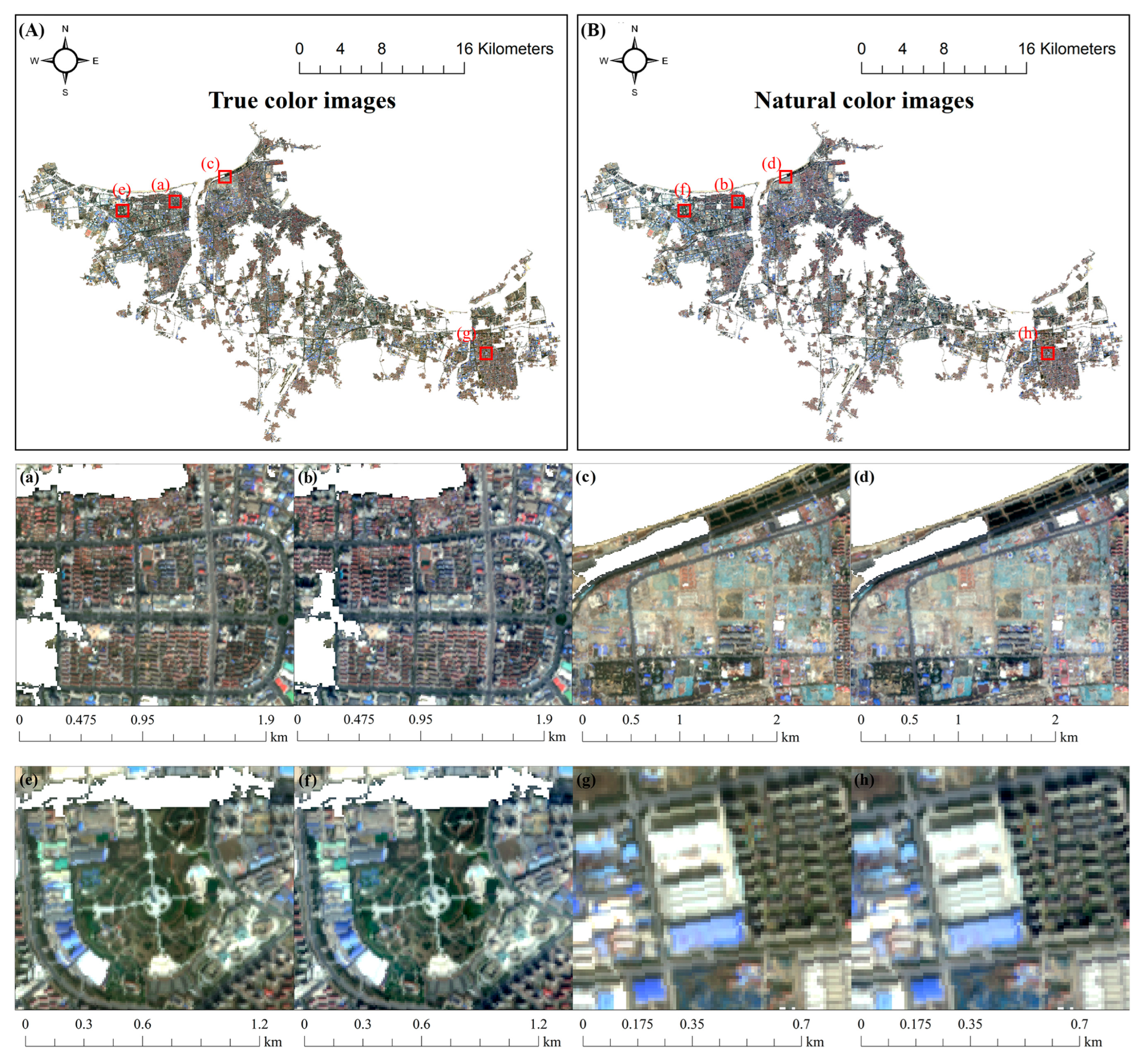

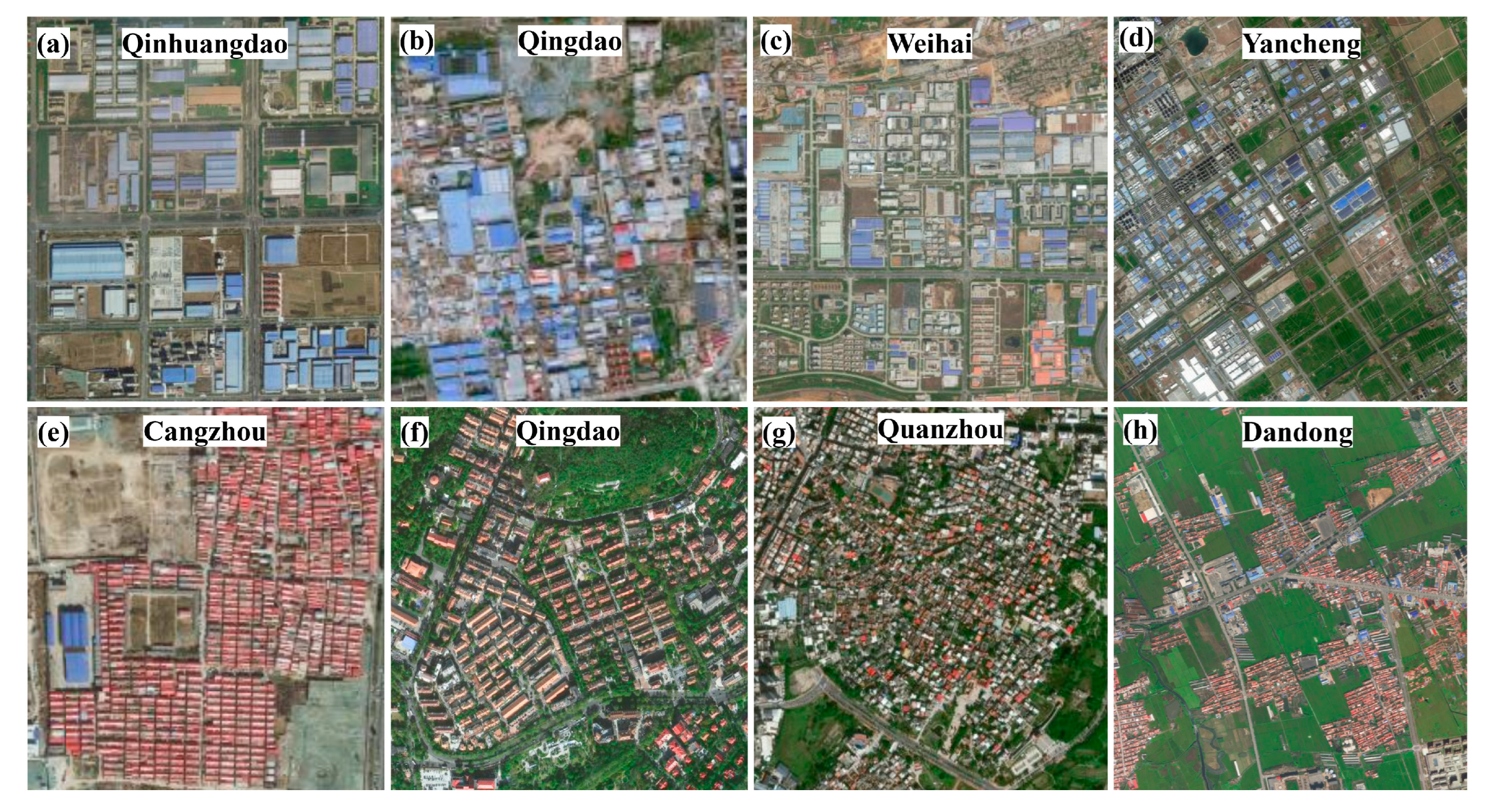
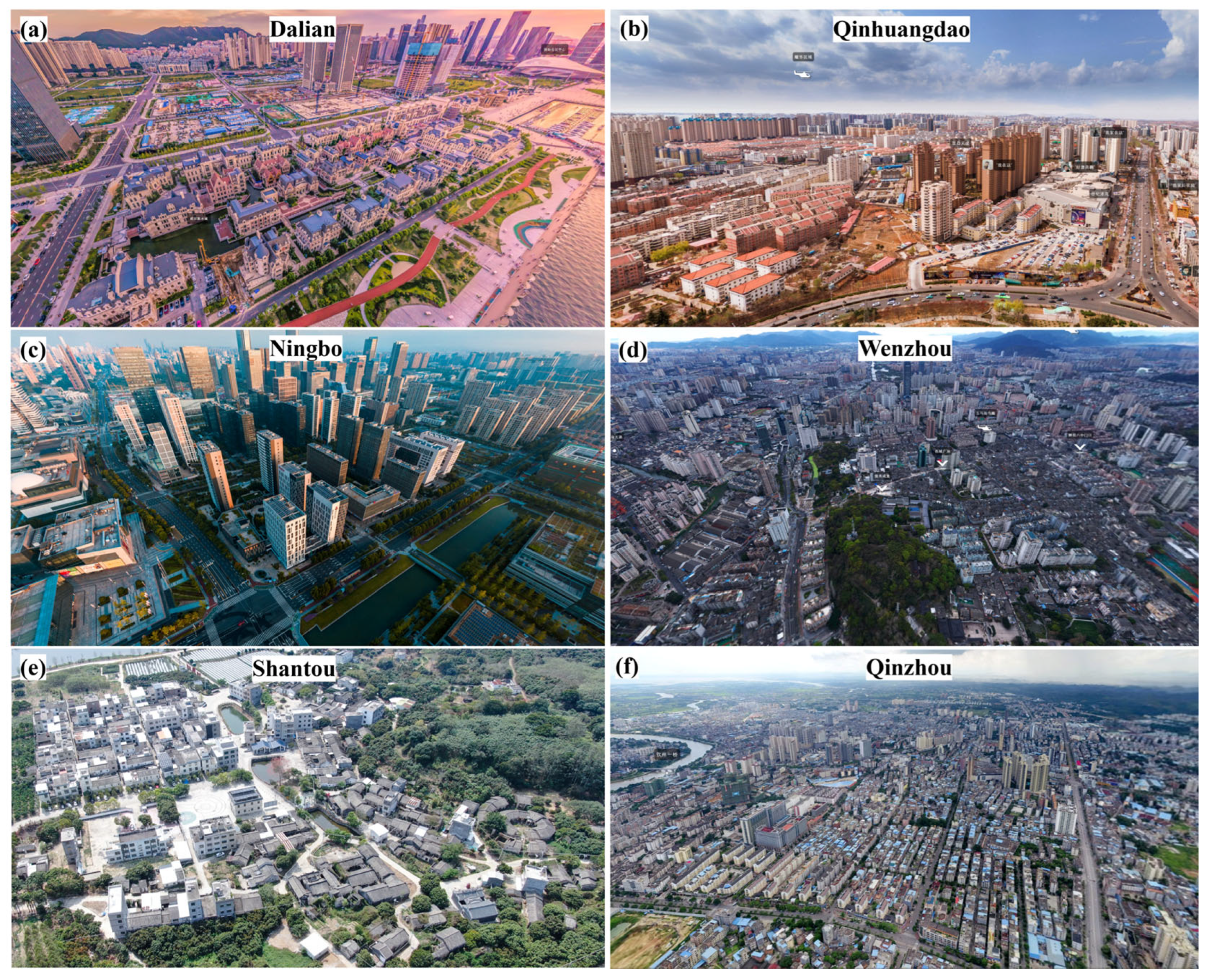
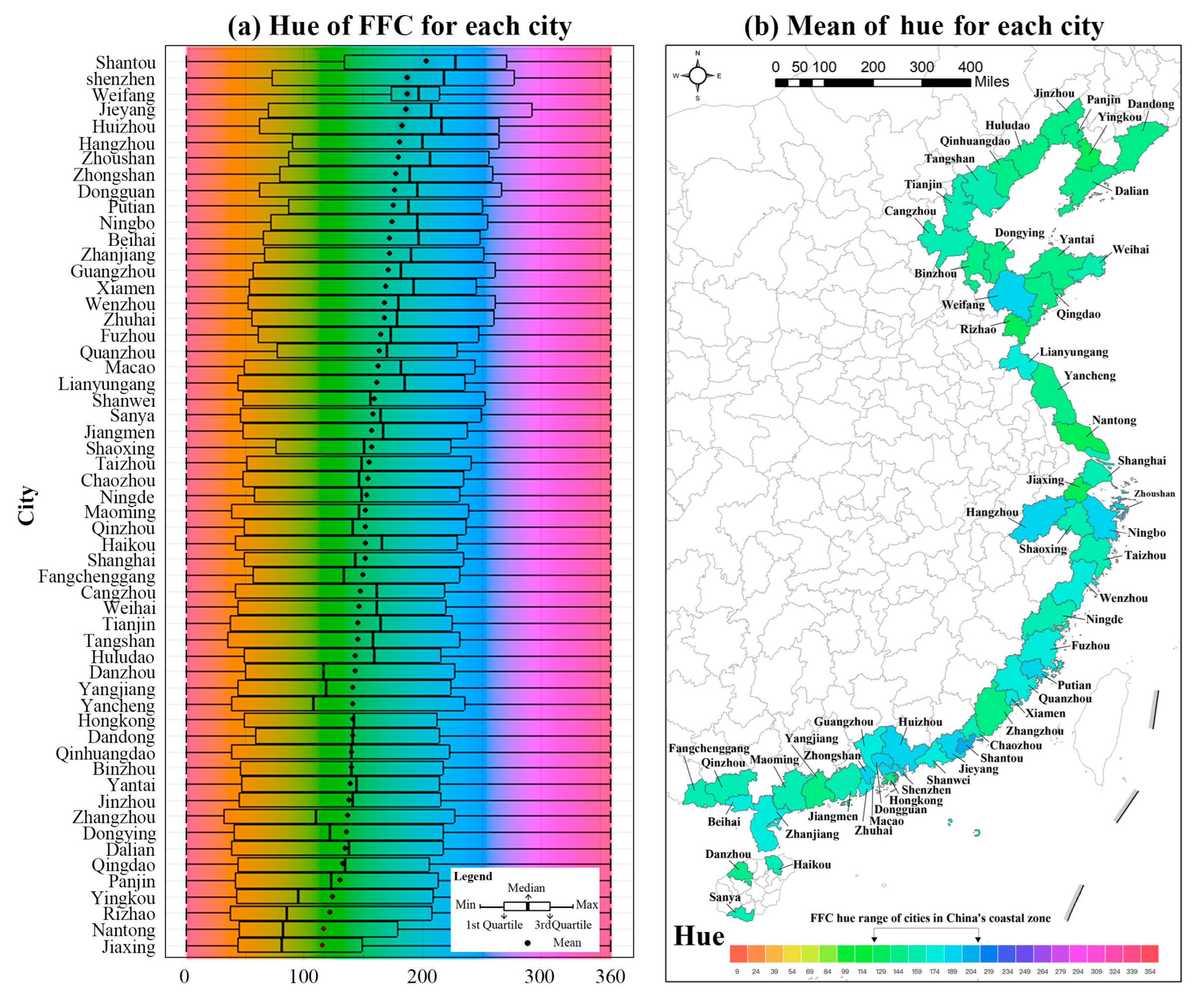
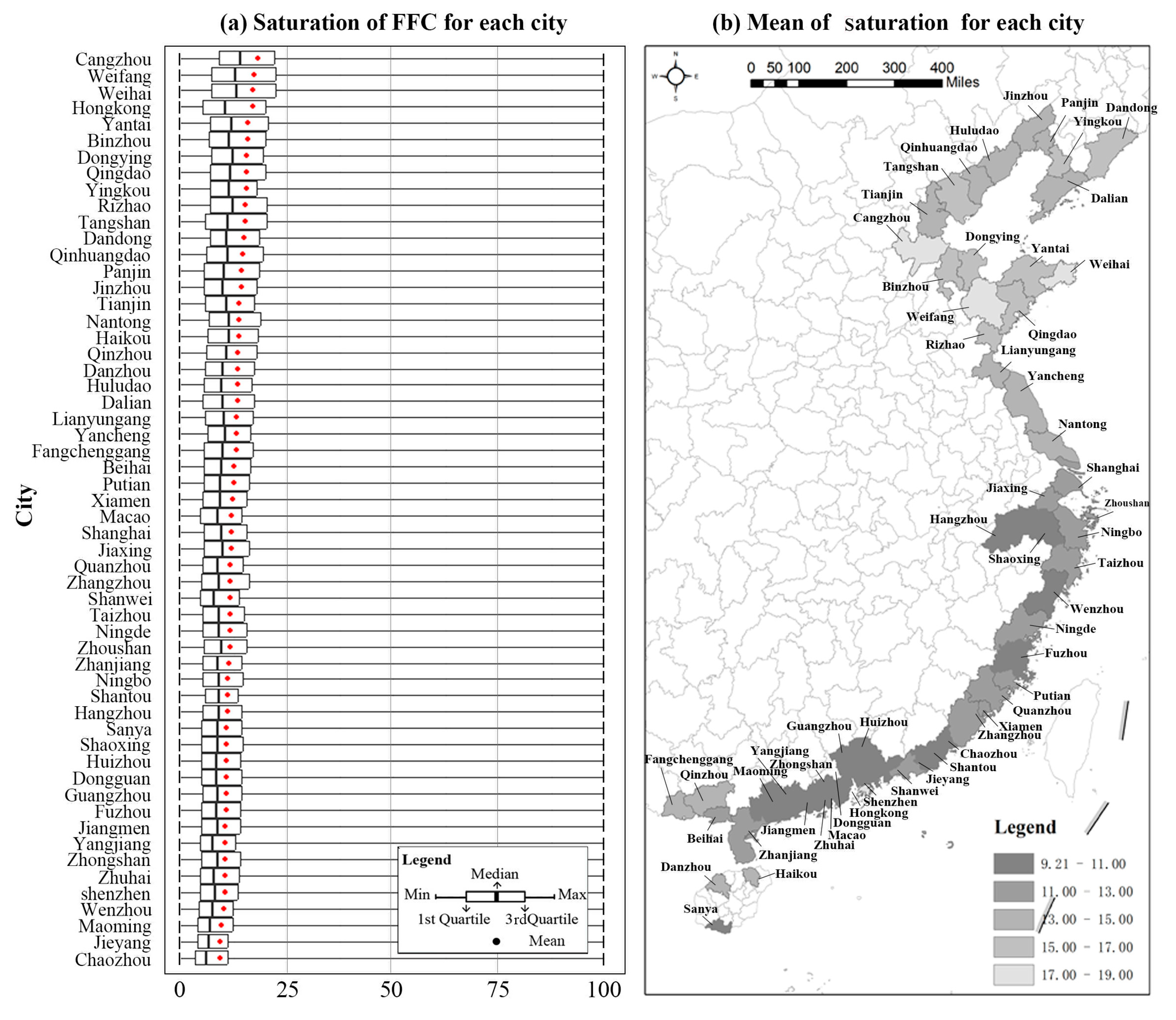
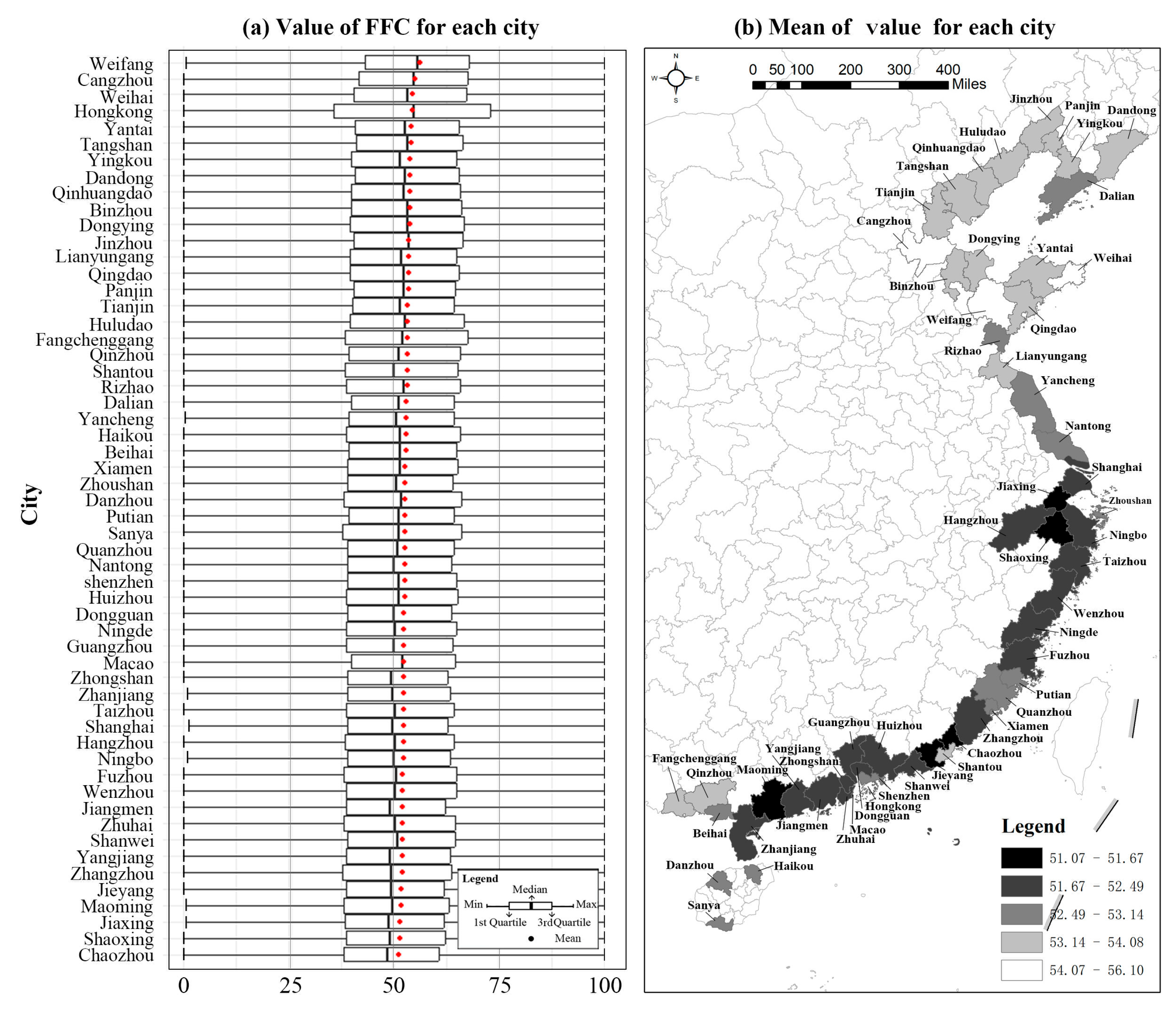
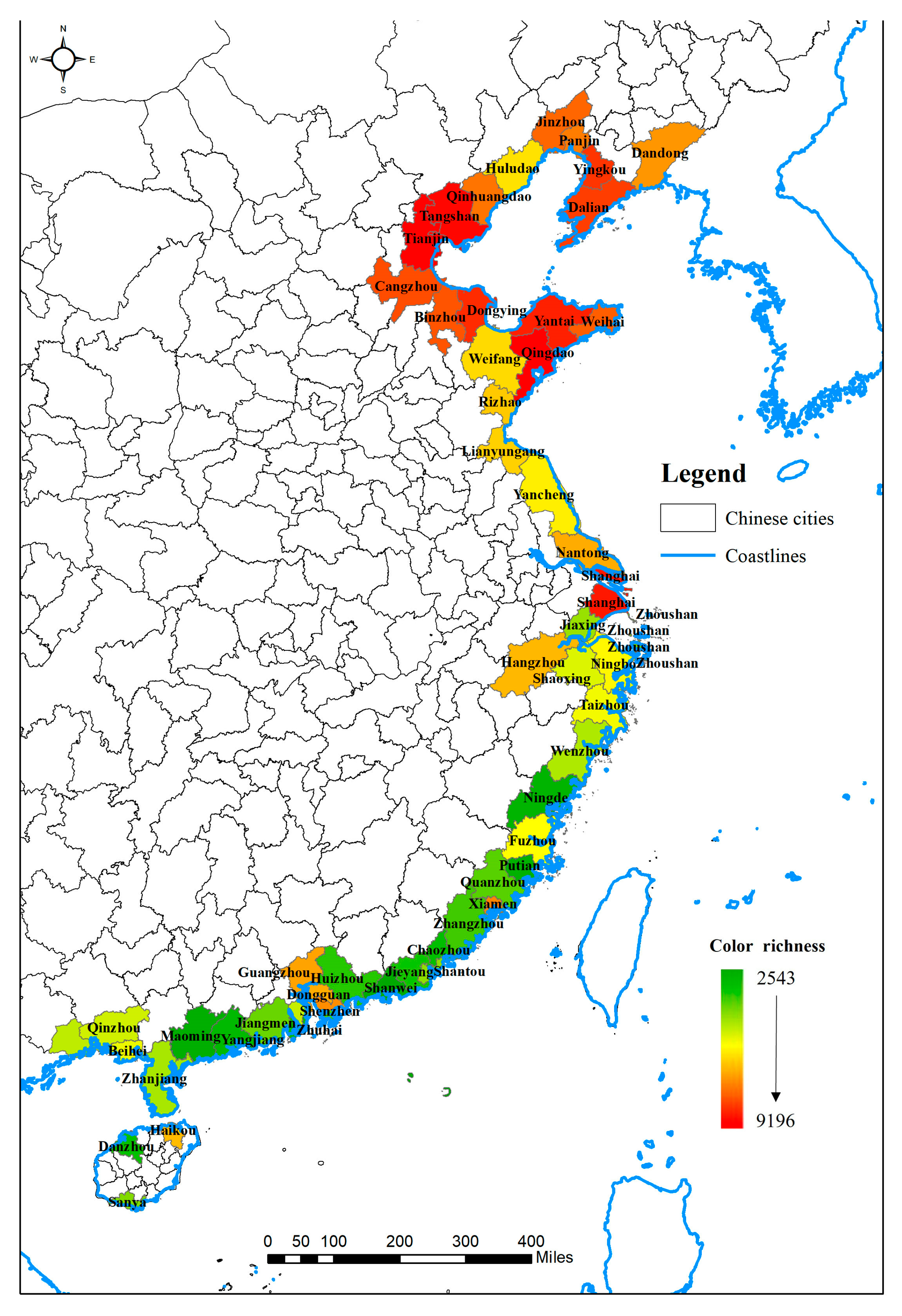
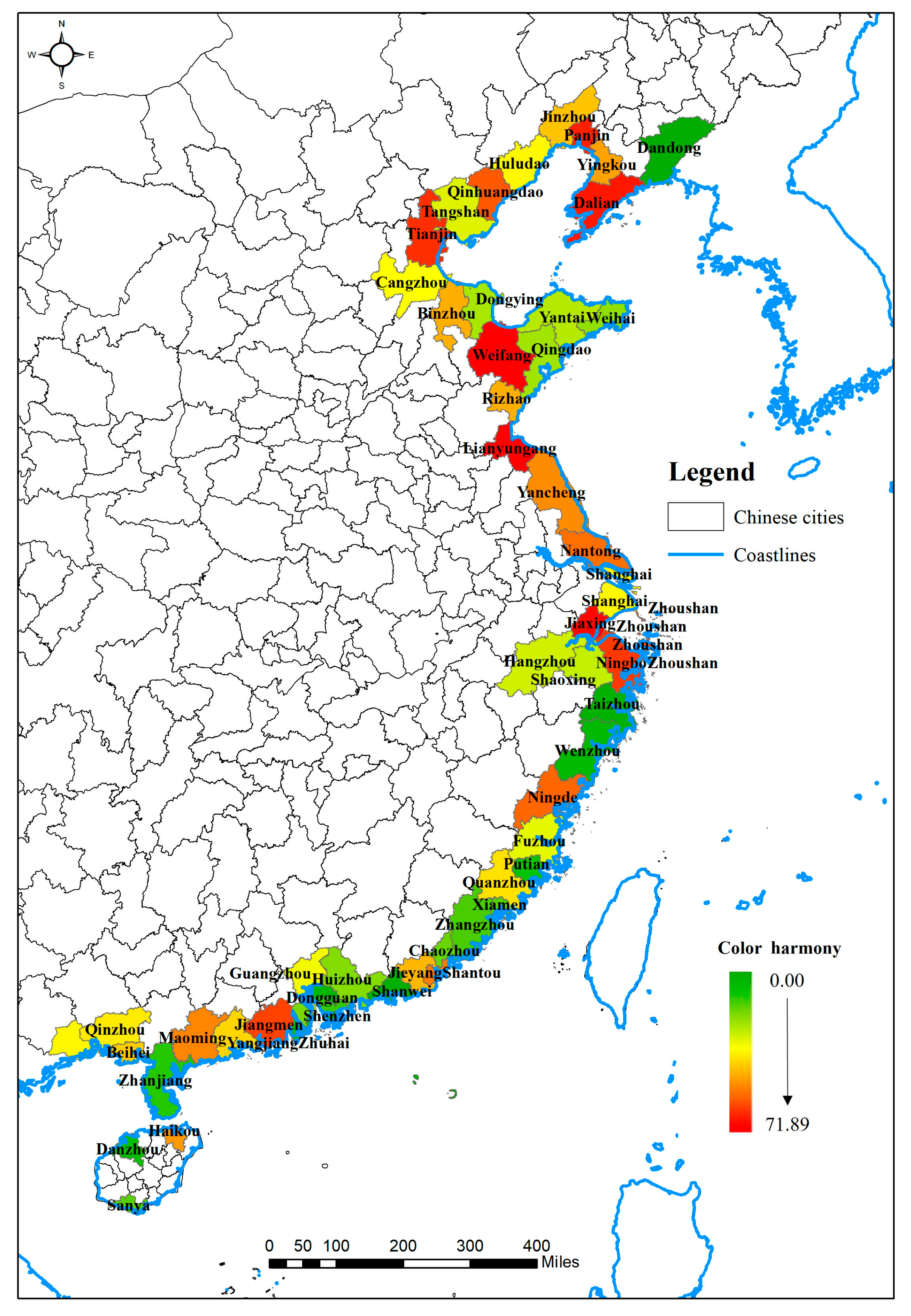
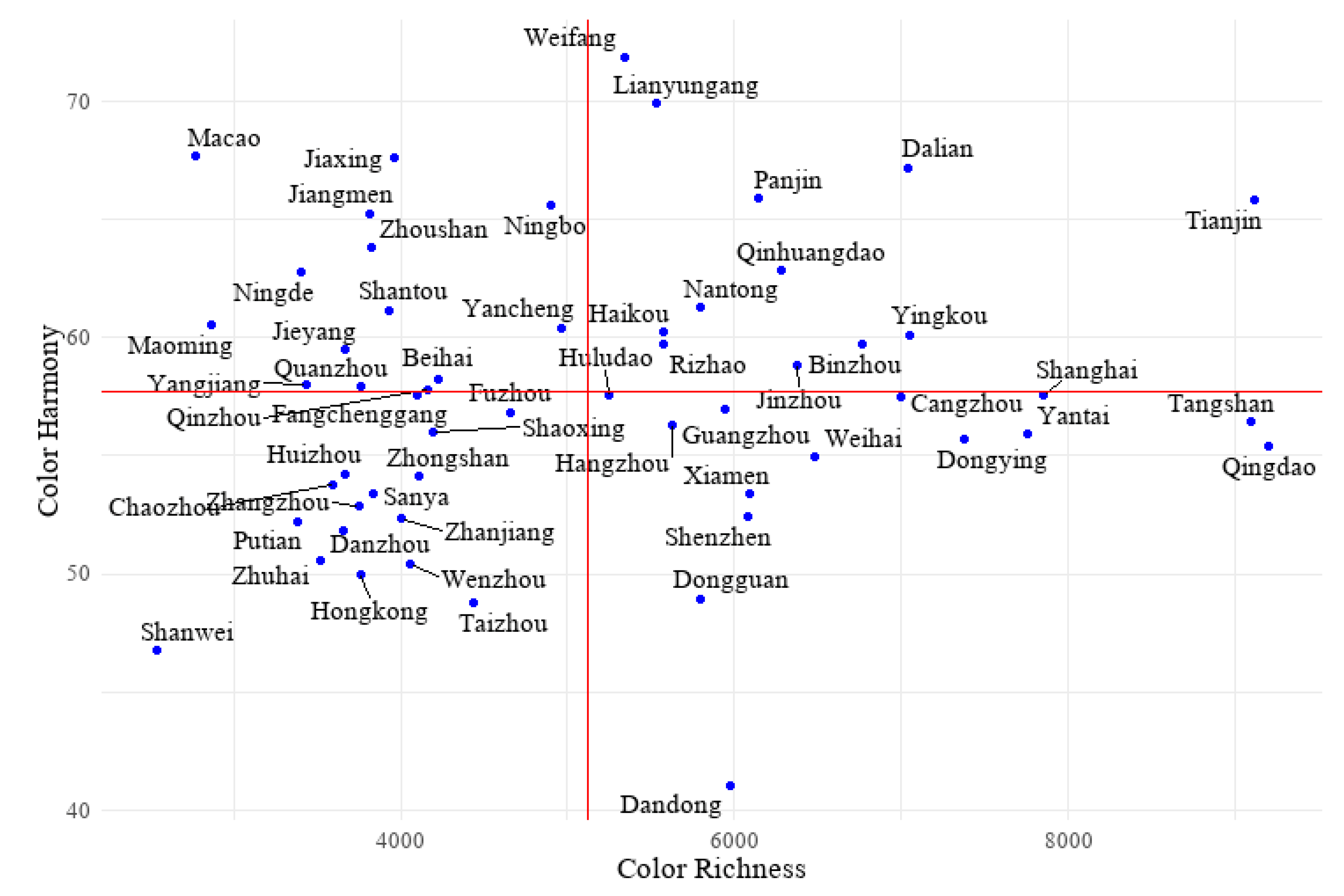
| Province Level | No. | City Level | Long. (°E) | Lat. (°N) | Province Level | No. | City Level | Long. (°E) | Lat. (°N) |
|---|---|---|---|---|---|---|---|---|---|
| Liaoning | 1 | Dandong | 124.40 | 40.54 | Fujian | 29 | Ningde | 119.49 | 26.97 |
| 2 | Dalian | 122.19 | 39.58 | 30 | Fuzhou | 119.20 | 26.05 | ||
| 3 | Yingkou | 122.45 | 40.39 | 31 | Putian | 118.90 | 25.44 | ||
| 4 | Panjin | 121.99 | 41.07 | 32 | Quanzhou | 118.27 | 25.19 | ||
| 5 | Jinzhou | 121.61 | 41.46 | 33 | Xiamen | 118.12 | 24.66 | ||
| 6 | Huludao | 120.21 | 40.62 | 34 | Zhangzhou | 117.45 | 24.33 | ||
| Hebei | 7 | Qinhuangdao | 119.19 | 40.09 | Guangdong | 35 | Chaozhou | 116.79 | 23.79 |
| 8 | Tangshan | 118.33 | 39.71 | 36 | Shantou | 116.60 | 23.33 | ||
| 10 | Cangzhou | 116.77 | 38.27 | 37 | Jieyang | 116.12 | 23.34 | ||
| Tianjin | 9 | Tianjin | 117.34 | 39.28 | 35 | Shanwei | 115.59 | 22.88 | |
| Shandong | 11 | Binzhou | 117.84 | 37.54 | 39 | Huizhou | 114.50 | 23.24 | |
| 12 | Dongying | 118.64 | 37.64 | 40 | Guangzhou | 113.54 | 23.33 | ||
| 13 | Yantai | 120.80 | 37.24 | 41 | Dongguan | 113.88 | 22.93 | ||
| 14 | Weihai | 121.99 | 37.12 | 42 | Shenzhen | 114.14 | 22.65 | ||
| 15 | Qingdao | 120.15 | 36.45 | 45 | Zhongshan | 113.39 | 22.52 | ||
| 16 | Weifang | 119.07 | 36.55 | 46 | Zhuhai | 113.36 | 22.15 | ||
| 17 | Rizhao | 119.14 | 35.58 | 47 | Jiangmen | 112.67 | 22.27 | ||
| Jiangsu | 18 | Lianyungang | 119.14 | 34.54 | 48 | Yangjiang | 111.78 | 22.03 | |
| 19 | Yancheng | 120.20 | 33.51 | 49 | Maoming | 110.95 | 22.01 | ||
| 20 | Nantong | 121.04 | 32.18 | 50 | Zhanjiang | 110.17 | 21.08 | ||
| Shanghai | 21 | Shanghai | 121.48 | 31.21 | Hongkong | 43 | Hongkong | 114.17 | 22.32 |
| Zhejiang | 22 | Jiaxing | 120.78 | 30.62 | Macao | 44 | Macao | 113.54 | 22.20 |
| 23 | Hangzhou | 119.47 | 29.90 | Guangxi | 51 | Beihai | 109.34 | 21.66 | |
| 24 | Shaoxing | 120.64 | 29.73 | 52 | Qinzhou | 109.02 | 22.17 | ||
| 25 | Ningbo | 121.48 | 29.73 | 53 | Fangchenggang | 108.01 | 21.87 | ||
| 26 | Zhoushan | 122.18 | 30.12 | Hainan | 54 | Haikou | 110.42 | 19.85 | |
| 27 | Taizhou | 121.14 | 28.76 | 55 | Danzhou | 109.39 | 19.58 | ||
| 28 | Wenzhou | 120.46 | 27.90 | 56 | Sanya | 109.42 | 18.364 |
| Band | Description | Wavelength (nm) | Resolution (m) |
|---|---|---|---|
| B1 | Aerosols | 433–453 | 60 |
| B2 | Blue | 458–523 | 10 |
| B3 | Green | 543–578 | 10 |
| B4 | Red | 650–680 | 10 |
| B5 | Red Edge 1 | 698–713 | 20 |
| B6 | Red Edge 2 | 733–748 | 20 |
| B7 | Red Edge 3 | 773–793 | 20 |
| B8 | NIR | 785–900 | 10 |
| B8A | Red Edge 4 | 855–875 | 20 |
| B9 | Water Vapor | 935–955 | 60 |
| B10 | SWIR/Cirrus Clouds | 1360–1390 | 60 |
| B11 | SWIR 1 | 1565–1655 | 20 |
| B12 | SWIR 2 | 2100–2280 | 20 |
| QC60 | Cloud Mask | / | 60 |
Disclaimer/Publisher’s Note: The statements, opinions and data contained in all publications are solely those of the individual author(s) and contributor(s) and not of MDPI and/or the editor(s). MDPI and/or the editor(s) disclaim responsibility for any injury to people or property resulting from any ideas, methods, instructions or products referred to in the content. |
© 2025 by the authors. Licensee MDPI, Basel, Switzerland. This article is an open access article distributed under the terms and conditions of the Creative Commons Attribution (CC BY) license (https://creativecommons.org/licenses/by/4.0/).
Share and Cite
Liu, Y.; Ye, R.; Jing, W.; Yin, X.; Sun, J.; Yang, Q.; Hou, Z.; Hu, H.; Shu, S.; Yang, J. Perceiving Fifth Facade Colors in China’s Coastal Cities from a Remote Sensing Perspective: A New Understanding of Urban Image. Remote Sens. 2025, 17, 2075. https://doi.org/10.3390/rs17122075
Liu Y, Ye R, Jing W, Yin X, Sun J, Yang Q, Hou Z, Hu H, Shu S, Yang J. Perceiving Fifth Facade Colors in China’s Coastal Cities from a Remote Sensing Perspective: A New Understanding of Urban Image. Remote Sensing. 2025; 17(12):2075. https://doi.org/10.3390/rs17122075
Chicago/Turabian StyleLiu, Yue, Richen Ye, Wenlong Jing, Xiaoling Yin, Jia Sun, Qiquan Yang, Zhiwei Hou, Hongda Hu, Sijing Shu, and Ji Yang. 2025. "Perceiving Fifth Facade Colors in China’s Coastal Cities from a Remote Sensing Perspective: A New Understanding of Urban Image" Remote Sensing 17, no. 12: 2075. https://doi.org/10.3390/rs17122075
APA StyleLiu, Y., Ye, R., Jing, W., Yin, X., Sun, J., Yang, Q., Hou, Z., Hu, H., Shu, S., & Yang, J. (2025). Perceiving Fifth Facade Colors in China’s Coastal Cities from a Remote Sensing Perspective: A New Understanding of Urban Image. Remote Sensing, 17(12), 2075. https://doi.org/10.3390/rs17122075







